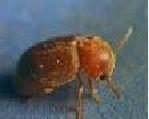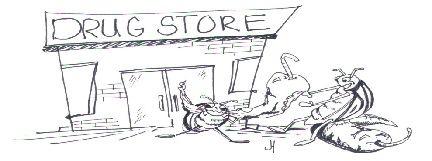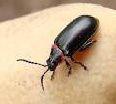Natural Solutions to Things That Bug You (46 page)
Read Natural Solutions to Things That Bug You Online
Authors: Myles Bader

They lay their orange-brown eggs at the base of the plants and eventually tiny whitish grubs will hatch. If you use quality mulch they will not lay their eggs there.
These beetles will cause the entire plant to wilt and fall over dead since the beetles carry the bacterial wilt disease in their digestive tracts. If you feel that the plant has been infected, just slice a vine in two and squeeze the ends until the plant juices are seen. If the plant juices are a milky white substance that can be drawn out in a thread, the plant; is being attacked by the bacteria and the rest of the plant is finished.
EASILY CONFUSED
Cucumber beetles are easily confused when they go in search of their favorite food cucumbers and summer squash. If you plant rattail radishes around the areas containing cucumber or cabbage plants it has the tendency to repel the beetles and they head for another yard. If you plant additional rattails between the plants it will provide additional protection.
CHECK THE DOWNSIDE
One of the best ways to control the beetles is to check the underneath sides of the leaves very early in the season. The leaves should be sprayed with a solution of insecticidal soap and water to eliminate the larvae and the eggs.
NEEM TO THE RESCUE
If you do end up with an infestation by mid-summer spray them first with Neem Oil™ to repel them from the vegetables and plants. Then you should follow-up with pyrethrums, which will kill them. These are both natural organic products, safe to use and fully biodegradable.
CALL FOR NEMA THE WORM
Nc nematodes will do the job nicely and eliminate the beetle. They don’t like radishes and if you plant them with the other vegetables they will stay away from the garden. Lime and soap sprays irritate them and they won’t come back.
PEPPER SPRAY
½ Cup of hot peppers or ¼ cup Tabasco Sauce™
2 Quarts of tap water
1 Tablespoons of Ivory Liquid Soap®
Place the hot peppers or Tabasco Sauce™ with 2 cups of water in a blender, blend thoroughly then allow it to stand overnight. Strain and add the balance of the water and the liquid soap and use as a spray.
VANILLA HELPS
These beetles will not go near your plants if you spray them with a solution composed of artificial vanilla flavoring and water.
WOOD ASH/LIME SPRAY
¼ Cup of wood ashes
¼ Cup of lime juice
1 Gallon of tap water
Mix all the ingredients together and allow it to stand for 1 hour before spraying on the plants. Be sure and spray the underneath sides of the leaves.
PLANT REPELLENTS
There are a number of plants that if planted between the plants that they eat it will repel them naturally. These are tansy, catnip, marigold and radishes.
DRUGSTORE BEETLES
General Information:
 The Drugstore beetle, also known as the bread beetle or biscuit beetle, is a very small, brown beetle that can be found infesting a wide variety of products and is among the most common non-weevils. They have a worldwide distribution and can be more commonly found in warmer climates. They are similar in appearance to the cigarette beetle), but are slightly larger, adults can be over 2¼ -inches in length.
The Drugstore beetle, also known as the bread beetle or biscuit beetle, is a very small, brown beetle that can be found infesting a wide variety of products and is among the most common non-weevils. They have a worldwide distribution and can be more commonly found in warmer climates. They are similar in appearance to the cigarette beetle), but are slightly larger, adults can be over 2¼ -inches in length.
Drugstore beetles have antennae ending in 3-segmented clubs, while cigarette beetles have serrated antennae (notched like teeth of a saw). The drugstore beetle also has grooves running longitudinally along the body, whereas the cigarette beetle is smooth.
Their larvae are small, white grubs and they can be distinguished from the grubs of the cigarette beetle by their shorter hair.
The female is capable of laying up to 75 eggs at once, and the larval period lasts up to several months depending on the food source. It is the larvae that are responsible for most of the damage that this species can cause.
Drugstore beetles have a tendency to feed on pharmacological products, including prescription drugs. They will also feed on a diverse range of dried foods and spices, as well as hair, leather and books. They can bore into furniture, and in some cases tin foil or sheets of lead.

ELM LEAF BEETLE
General Information:
 This is a small to ½ inch yellow and either black or brown beetle that may have yellow with green and black stripes. The adults may winter over in protected areas, tree bark or an old barn.
This is a small to ½ inch yellow and either black or brown beetle that may have yellow with green and black stripes. The adults may winter over in protected areas, tree bark or an old barn.
They may get into your house in the fall and return to the elm trees in the spring. They will feed on the foliage and leave tiny holes in the leaves.
 The larvae looks like a small black caterpillar and changes to a dull yellow with black stripes when they mature. They love to eat the underside of elm leaves and will eventually skeletonize them. They will feed for several weeks before falling to the ground and pupate. Look for bright yellow pupae around the base of the elm tree and can produce 1-3 generations per season.
The larvae looks like a small black caterpillar and changes to a dull yellow with black stripes when they mature. They love to eat the underside of elm leaves and will eventually skeletonize them. They will feed for several weeks before falling to the ground and pupate. Look for bright yellow pupae around the base of the elm tree and can produce 1-3 generations per season.
SPRAY THOSE TREES
One of the most effective methods to get rid of the beetle is to spray the trees with a mixture of pyrethrum according to the label on the container.
BENEFICIALS TO THE RESCUE
You can apply either Bacillus thuringiensis (BT) or tenebrionis to kill the larvae. You will need to apply them when the eggs hatch from late May to June. This is a safe and very effective method of eliminating the problem.
FLEA BEETLE

Identification:
This is a jumping beetle that is only ¼ inch in length. It is usually black with pale yellow stripes. It loves to consume young leaves and makes tiny holes in them.
General Information:
Their larvae feed on seeds and some roots. They will also feed on dichondra grass, cabbage, broccoli and cauliflower. In California there is a species of flea beetle that loves arugula. If you grow tomatoes the flea beetle may be found eating the early leaves but then leave before the fruit arrives. The damage they inflict looks like the plant was hit by a shotgun blast of small buckshot. Most plants recover, the only exception is eggplant.
FLEE BEETLE
The flea beetle loves cabbage leaves and will eat hundreds of holes in them, during their feast. To get rid of them, just use a garlic mixture. Just pulverize about 6 cloves of garlic with a hammer or run the car over them. Place the smashed garlic cloves in a glass jar and add1 tablespoon of cayenne pepper and 1 quart of warm tap water. Place a lid on and mix well, then allow the jar to stand in the sun for 2 days to steep. Spray the leaves with beetles, making sure you spray both sides of the leaves.
THESE BEETLES LOVE YELLOW
If you are having a problem with flea beetles, just purchase some yellow cards and place non-setting glue or Tanglefoot™ on them, then leave them in the areas you are having a problem.
They are attracted to the yellow color and will jump on the yellow and can’t escape. This will get rid of a number of other flying pests.
KEEPS THEIR BREATH FRESH
Flea beetles do not like mint. If you want to keep them away from your cabbage, just plant some mint plants among the cabbage.
WORMWOOD WILL DO THE TRICK
2 Cups of wormwood leaves
2 Quarts of tap water
2 Cups of boiling water
Place the wormwood leaves in the boiling water and allow the leaves steep for 1 hour. Strain the mixture and add the 2 quarts of water and place into a sprayer for immediate use. This will eliminate the flea beetles and cabbageworms.
PLANTS THAT REPEL THE FLEAS
There are a number of plants that are capable of repelling the flea beetle. These include elderberry, catnip, marigolds, garlic, wormwood, tansy and mint.
THE FLYING FLYPAPER
Try waving strips of flypaper over the plants. This will disturb the flea beetles and make them jump into the air getting snared on the flypaper. This is one of the most effective methods of getting rid of them.
